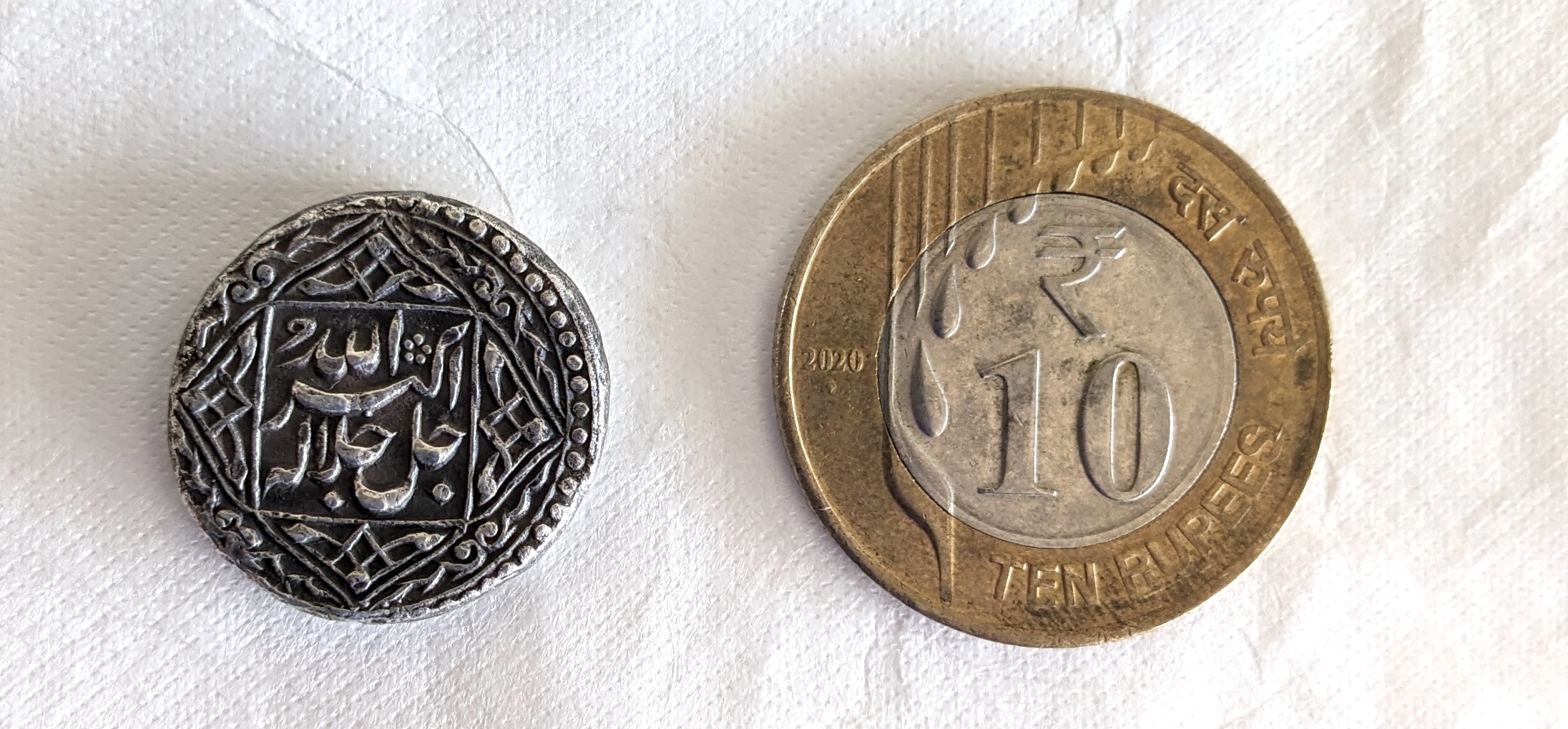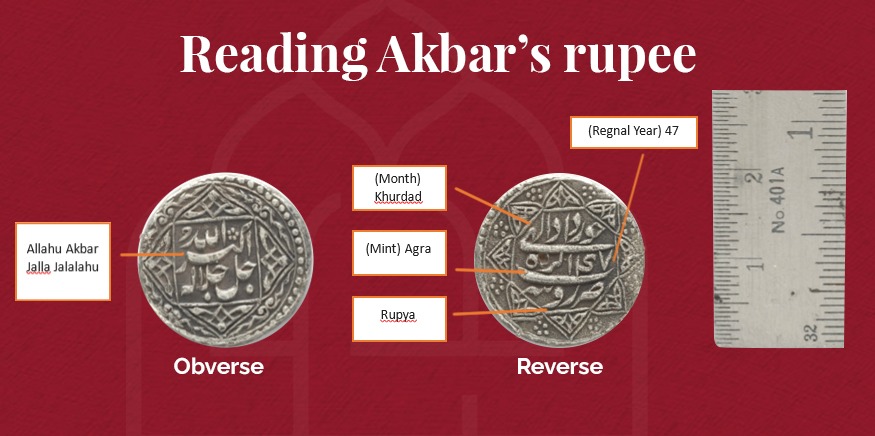
Image: Silver ‘rupaya’ coin issued by Mughal emperor Akbar placed next to a 10-rupee coin, circa 2020, for scale © Sarmaya Arts Foundation
Two years before he quit the throne of Hindustan, Mughal emperor Akbar added a small detail to the face of his coins that would become a fixture on Indian money four centuries later. For the first time ever, in 1603 CE, the word ‘rupaya’ appeared on a coin. An early form of ‘rupee’, which prevails today in five Asian countries, and an African one. India, Pakistan, Bangladesh, Nepal, Sri Lanka and the Seychelles can trace their numismatic history to this landmark series of coins forged in an Agra mint in the 47th year of Akbar’s reign.
In Akbar’s biography Ain-e-Akbari, written by his chief secretary Abu’l Fazal, we learn that the terms ‘rupaya’, ‘darb’ and ‘charan’ referred to one, half- and quarter-rupee denominations. During the first half of his 49-year reign, the badshah continued minting the Shahrukhi coins of his forebears, Babur and Humayun. By the second half, he had established a trimetallic currency system consisting of gold coins called mohurs, silver rupees, and copper daams.
Akbar hired calligraphers to engrave legends on coin dies and standardised the weight of the silver rupee to 11.5 grams, making it the heaviest silver coin at the time in the world. He established mints at Agra, Lahore, Delhi and Ahmedabad. An interesting aspect of Akbar’s coinage was that it used no alloys—coinage metals were as close to the pure element as was permitted. In the oft-quoted words of numismatist John Deyell, “Mughal currency had currency.”
Flipping the coin

Image: Silver rupee, issued by Mughal emperor Akbar, regnal year 47 (1603 CE), Agra mint © Sarmaya Arts Foundation 2023.N.172.2
Akbar introduced some interesting and some controversial changes to Mughal coinage. A major one was the shift in calendars, from the Hijri to Ilahi era, during the 30th year of his reign in AH 993/1585 CE. Gone was certain religious text, like the Kalima Shahada and the names of the four Khalifas, which were fixtures on the coins of Babur and Humayun. In their place, Akbar rolled out a new Ilahi formula based on the syncretic faith he professed called Din-e-ilahi.
Coins of this era have the legend, ‘Allahu Akbar Jalla Jalalahu’, on the obverse and the reverse, carries the Ilahi year, Persian month and name of the mint. Later Mughals continued the practice of inscribing regnal year and mint name on their coins. Akbar also brought beauty to the art of coin-making. Coins of his reign were decorated with dotted borders, elegant patterns and motifs, such as the hawk. This opened the doors to numismatic experimentation, which his successor Jahangir elevated to an artform in itself.
References:
- Kaur, Dr. N. (2018). The Journey of Indian Rupee from 1947 to Present. International Journal of Research in Engineering, IT and Social Sciences, Volume 08 (Issue 06), ISSN 2250-0588. P.19
- Classical Numismatic Gallery. (n.d.).
- Hussain, N. (2020). Early Mughal Coins: A Powerful History (Part One). Medieval and Early Modern Orients
- Goyal, S. (1999). THE ORIGIN AND ANTIQUITY OF COINAGE IN INDIA. Annals of the Bhandarkar Oriental Research Institute, 80(1/4), 125–154.
- Burange, L. G., & Ranadive, R. R. (2013). Indian Currency, exchange rate regime and policy. ResearchGate.
- Mookerji, R. K. (1960). Chandragupta Maurya and His Times. Madras University. P.214.
- Team Mintage World. (2020, February 21). Kalachuri Dynasty – Blog | Mintage World. Blog | Mintage World.
- Sandeep Balakrishna, & Sandeep Balakrishna. (2021, June 7). The brief and delightful history of the dramma in India. The Dharma Dispatch.
- Patra, B. (2008). Merchants, Guilds and Trade in Ancient India: An Orissan Perspective. Annals of the Bhandarkar Oriental Research Institute, 89, 133–168.
- Waghmare Ekta. COINS OF MUGHAL PERIOD: UNHEARD ASPECTS. (2021). International Research Journal of Modernization in Engineering Technology and Science, Volume:03 (Issue:10).



